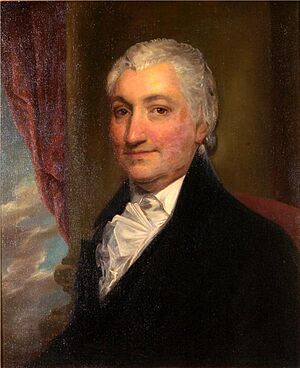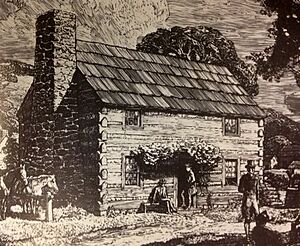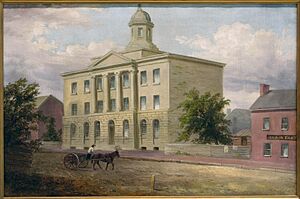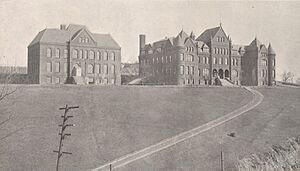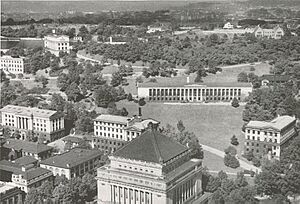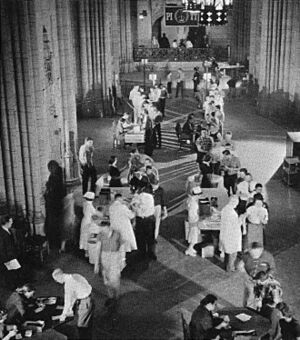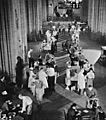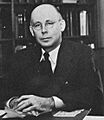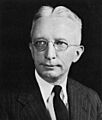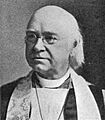History of the University of Pittsburgh facts for kids
The University of Pittsburgh, often called Pitt, is a big university in Pittsburgh, Pennsylvania, United States. For most of its history, Pitt was a private school. But in 1966, it became part of the Commonwealth System of Higher Education, which means it gets some money from the state.
Contents
Early History of Pitt
How Pitt Began
The University of Pittsburgh started as Pittsburgh Academy in 1787. It was founded by Hugh Henry Brackenridge. This makes Pitt one of the oldest universities in the U.S. It's also the oldest school west of the Allegheny Mountains that has been open continuously.
The school began as a prep school, probably in a log cabin. Western Pennsylvania was a frontier back then! In 1790, a brick building was built for the academy. It was a small, two-story building with three rooms.
Becoming a University
Soon, people in the area needed more advanced education. So, in 1819, the state of Pennsylvania changed the school's charter. This made it a university! The school was renamed the Western University of Pennsylvania, or WUP. It was meant to be like a sister school to the University of Pennsylvania in Philadelphia.
By 1830, WUP moved into a new, bigger building in downtown Pittsburgh. The university faced money problems because the state wanted it to teach more job skills, not just traditional subjects. But the university stuck to its plan of offering a broad education. Thomas Mellon, who later started Mellon Bank, graduated from WUP in 1837.
Fires and Moves
The university's buildings and most of its records were destroyed in a huge fire in 1845. This fire wiped out a big part of Pittsburgh. Classes were held in a church until a new building was built. But just four years later, that new building also burned down!
Because of these terrible fires, the university closed for a few years to rebuild. By 1854, WUP built a new, almost fireproof brick building. Classes started again in 1855. During this time, in 1867, Samuel Pierpoint Langley became the director of the Allegheny Observatory. He was an inventor and aviation pioneer.
In 1882, another fire damaged the county courthouse. So, the university sold its buildings to the county and moved its campus out of downtown. WUP moved to Allegheny City (now Pittsburgh's North Side). It eventually settled on a 10-acre site on Observatory Hill.
Growth on the North Side
Two main buildings were built on Observatory Hill in 1889 and 1890. In 1889, Pitt formed its first college football team. The Western Pennsylvania Medical College joined the university in 1892. By 1893, the university had its first African-American graduate, William Hunter Dammond.
In 1895, Pitt started its School of Law. Important people like Andrew Carnegie and George Westinghouse joined the university's board. The Pittsburgh College of Pharmacy and Pittsburgh Dental School also joined in 1896. In 1898, the first women, Margaret and Stella Stein, graduated. During this time, engineering professor Reginald Fessenden did important work in radio broadcasting. By 1904, the football team had its first undefeated season!
The 20th Century at Pitt
A New Name and Home
In 1908, the Western University of Pennsylvania was renamed the University of Pittsburgh. This was to avoid confusion with the University of Pennsylvania and to connect the school more closely with the city.
Pitt had also outgrown its North Side campus. Its different departments were spread out across the city. To bring everything together, WUP bought 43 acres of land in the Oakland neighborhood of Pittsburgh in 1907. Departments started moving there by 1909. The first plan for the campus was a Greek Acropolis design with 30 buildings. However, only four of these were built, and only Thaw Hall remains today.
Chancellor Samuel McCormick led the university during this time. He helped Pitt gain national recognition and grow a lot. He also started supporting sports at the university.
World War I and Expansion
When the United States entered World War I in 1917, all male college students had to get military training. Pitt began training students for war-related jobs. The U.S. Army built barracks and a mess hall on campus for 1,000 men.
The war brought many new students to Pitt, causing a shortage of space. By 1920, Pitt alumni started a campaign to raise money for a new building. They raised $670,000! This was partly because the Pitt football team was doing so well, winning championships in several years. By 1921, Alumni Hall (now Eberly Hall) was built. This building showed a new direction for the campus design. The excitement for football also led to the building of Pitt Stadium in 1925.
A National Landmark: The Cathedral of Learning
In the 1920s, Chancellor John Gabbert Bowman had a big idea for a tall, central building for the university. Pitt bought 14 acres of land in Oakland. Plans for the campus changed to a Gothic Revival style. This led to the Cathedral of Learning, Heinz Memorial Chapel, and Stephen Foster Memorial buildings.
By 1925, Bowman chose a design for the "tall building": a 535-foot tower. He wanted its height to show the "courage" and "fearlessness" of an educated person. The building was paid for by donors and by a campaign that collected dimes from local school children! Even though the Great Depression happened, construction on the Cathedral of Learning began in 1926 and finished in 1937. It's still the second-tallest education building in the world and has 26 amazing nationality rooms inside.
Next to the Cathedral, the Stephen Foster Memorial was also finished in 1937. It has theaters and a music center. The French Gothic Heinz Memorial Chapel was dedicated in 1938. The Heinz family wanted it to be a "great space" for worship, music, and weddings. Its tall windows are some of the tallest in the world.
The Pitt Polio Vaccine
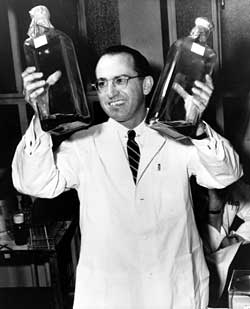
Poliomyelitis (polio) was a terrible disease that crippled many people. In the early 1900s, polio epidemics hit the U.S. and other countries. Hospitals filled with patients in "iron lungs," and many were left unable to move. People were very scared of catching polio.
In 1947, Jonas Salk came to Pitt. He set up the university's Virus Research Lab in the basement of what is now Salk Hall. By 1951, Salk and his team started testing a polio vaccine using a dead virus. Soon, Salk began testing it on people. By 1953, human trials began among the general public, mostly in Allegheny County.
By 1955, the "Pitt vaccine," developed by Salk and his Pitt team, was declared effective! By 1962, Pitt's vaccine had reduced polio cases in the U.S. by 95 percent. Together with another vaccine, it wiped out naturally occurring polio in North and South America and Western Europe. Salk's work at Pitt is seen as one of the most important scientific achievements ever.
Becoming State-Related
In 1966, the state made Pitt a state-related university. This means it gets public money (over $160 million a year now). This allows Pitt to offer lower tuition to Pennsylvania residents, but the university still controls itself.
After becoming state-related, many more students came to Pitt, and the university grew quickly. In the 1970s, Pitt's football team became famous again. They won a national championship in 1976 with Hall of Fame running back Tony Dorsett. Quarterback Dan Marino also played for Pitt in the 1980s.
In the 1980s, important medical research in organ transplantation was done by Thomas Starzl at Pitt. This made Pitt a world leader in this field. Chancellor Wesley Posvar retired in 1991 after 24 years. He helped Pitt pay off its debt and made the school more famous.
Into the 21st Century
In 1999, Pitt Stadium, the old home of the Pitt Panthers football team, was torn down. The team moved downtown to Heinz Field in 2001. A large arena, the Petersen Events Center, was built for the university's basketball teams and graduation ceremonies. It also has a big student recreation center.
Other new buildings and renovations have happened on campus. The old Masonic Temple became Alumni Hall. New dorms were built, and the Sennott Square building was constructed. Mark Nordenberg was chancellor from 1995 to 2014. He led Pitt through a time of great progress, raising over $2 billion for the university. The current chancellor is Patrick D. Gallagher. Pitt's endowment (its savings) reached $4.29 billion in 2018-2019, ranking it among the top universities.
Leaders of the University of Pittsburgh
The leader of the university was first called "Principal" when it started. Even after Pittsburgh Academy became a university in 1819, the title "Principal" was used until 1872. Then, the title changed to "Chancellor." In 1984, it briefly changed to "President" but went back to "Chancellor" later. The university considers Robert Bruce to be its first chancellor, starting in 1819. The current chancellor is Patrick D. Gallagher.
Images for kids


